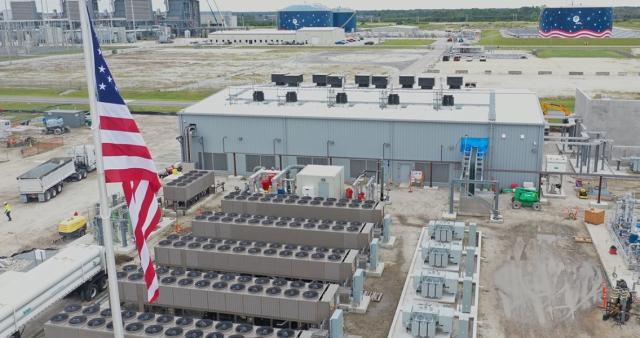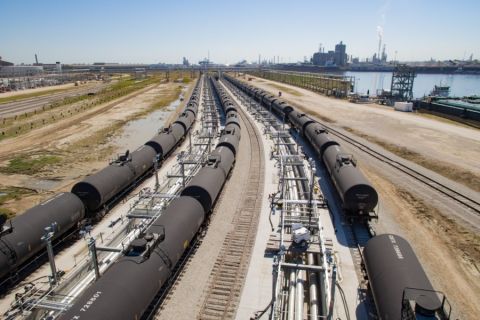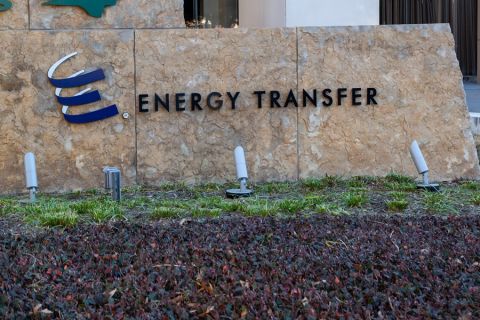
Florida Power & Light says its Cavendish NextGen Hydrogen Hub will help the company explore use clean hydrogen to offset natural gas at a traditional power plant. (Source: Florida Power & Light Co.)
One way hydrogen suppliers could help solve the demand-side dilemma facing their nascent industry is to form partnerships early on with customers, according to executives speaking this week at a hydrogen-focused energy conference.
As it now stands, the number of announced hydrogen projects exceeds demand, though need for the clean or low-carbon energy source is expected to grow in the coming years amid the global decarbonization push.
Hydrogen is mostly used today for oil refining, production of ammonia and an ingredient for fertilizer but has the potential to decarbonize sectors such as steel, maritime and aviation; power fuel cells; generate electricity; and serve as a transportation fuel—displacing carbon-emitting fossil fuels.
RELATED: Hydrogen’s Nagging Question: Where’s the Demand?
Hydrogen has already been the source of unusual collaborations, bringing companies from different industries together in pursuit of net-zero emissions or other carbon management efforts. They are also coming together in hopes of landing federal funding to help establish hydrogen hubs across the U.S. to strengthen the sector.
The saying “If you want to go fast, go alone. If you want to go far, go together,” came to mind for Matias Saettone, general manager of hydrogen products for Chevron Corp. As the company looks to connect supply and demand, it aims to integrate partners across the value chain to make hydrogen developments a reality.
RELATED: NextEra Energy CEO Sees Hydrogen as Next Frontier, Calls Offshore Wind ‘Bad Bet’
Q&A: Mitsubishi Power Americas Aims for Ambitious Hydrogen Storage Hub
Customers as partners
Chevron, for example, teamed up with Air Liquide, LyondellBasell and Uniper to evaluate a low-carbon hydrogen and ammonia project on the U.S. Gulf Coast. It is also working on hydrogen in mobility applications with Toyota, BNSF for railroads and with Caterpillar Inc. for development projects in transportation and stationary power applications.
It’s “not necessarily the traditional view on the relationship between a supplier and a buyer or a customer, but more a customer as partner,” Saettone said. “For us, that is critical because by working very closely with customer partners … we can understand how this could make sense. We can understand what that customer partner needs.”
Such relationships foster a better understanding of how the customer-partner operates and what it needs—from specific products to following regional policies worldwide—to succeed. Otherwise, the company risks developing solutions, products or commodities that do not serve the needs of the end user, he said. He added that its critical to extend partnerships to governments.
Customer partners also help Chevron understand the direction some policies are trending, Saettone added, “so that we can then engage with policymakers and regulators to help them define what those pathways could look like.”
The key to successfully advancing hydrogen as a decarbonization tool will come down to building solutions to scale with speed, according to Saettone. That requires clear policy, standards and participation by all, he said.
For Mitsubishi Power Americas, moving the hydrogen needle forward involves being first, being collaborative and being abundant, according to Michael Ducker, the company’s senior vice president of hydrogen infrastructure.
RELATED: NextEra CEO: Strengthening Hydrogen Sector Requires Partnerships
Moving forward
In 2019, Mitsubishi partnered with Magnum Development—which was acquired by Chevron— to develop the world’s first and largest clean, integrated hydrogen hub in Delta, Utah. Ducker recalled the project’s naysayers at the time.

“I was told that we were throwing away our money. I was told this was a science experiment. I was told this was the hydrogen economy failure all over again and this is literally just a little more than three years ago. Yet here I stand today and we’ve delivered,” Ducker said.
The Advanced Clean Energy Storage in Delta (ACES Delta) will initially convert more than 220 megawatts of renewable energy into 100 metric tonnes per day of green hydrogen to be stored in two gigantic 4.5 MMbbl salt caverns. The cavern will store hydrogen, providing long-duration energy storage that can be dispatched when needed to the grid.
“We completed drilling just this past summer for both of our caverns ahead of schedule. At nearly a mile beneath the earth, we’re constructing caverns the size of the Empire State Building with little more to show for it than a 15-foot-tall wellhead aboveground,” Ducker said. “Our hydrogen capable gas turbines arrived at site just this past July at our partner’s site, and our construction continues on the aboveground facilities. And very exciting, literally just last week, the electrolyzers just started rolling in on train cars. And as we sit here and speak today, they’re being installed at site.”
Mitsubishi’s diverse set of stakeholders includes companies from “power to mobility to heavy industrial users, from electrolyzer manufacturers to reformer providers, from renewable energy suppliers to natural gas suppliers and from U.S. ports to European ports.”
Getting projects across the finish required partners.
“Hydrogen’s natural state is to be collaborative. Combined with a carbon molecule, we’ve got natural gas. Combined hydrogen with oxygen, and we’ve got water. Combine hydrogen with nitrogen, we’ve got ammonia,” Ducker said. “The name of the game is collaboration, and that’s going to be paramount to success in this industry.”
He called on others to help actively shape the market.
Learning lessons
NextEra Energy Resources has jumped onto the hydrogen scene as the company evaluates about $20 billion in investment opportunities that require about 15 gigawatts of renewable energy.

One of the projects is Cavendish, a clean hydrogen pilot project with its sister company Florida Power & Light Co (FPL).
Rebecca Kujawa, president and CEO of NextEra Energy Resources, said the project is “within a couple of months of reaching commercial operations in Florida.”
The project uses solar energy to make hydrogen. Hydrogen will be blended (5%) with natural gas and tested in one of FPL’s three natural gas combustion turbines, FPL said on its website on Oct. 11.
NextEra is “learning a lot already in that process. And no doubt we’ll learn a lot more as we reach operations with that facility,” Kujawa said. Some of these lessons are coming from the construction standpoint as well as about limitations and flexibility associated with electrolyzer technology.
Such pilot projects are considered learning opportunities for the company as it gears up to consider bigger capital commitments. Kujawa compared the small investment in hydrogen to similar ones previously made in battery storage.
“Quite transparently, the returns were not terrific from a pure finance green eyeshade kind of perspective. But if you think about it in context of what we learned and what mistakes we prevented … then the billions of dollars we subsequently committed to battery storage, those were some of the best investments we’ve ever made,” she said. “And I fully expect Cavendish to be right there alone along those lines.”
She added that the company is fortunate that Florida has grown to appreciate how early investments pay off for customers in delivering “affordable, reliable, low-cost energy supply.”
Awaiting more guidance
Like others, Kujawa mentioned collaboration and the need for finalized rules on the U.S. Inflation Reduction Act’s production tax credit and regulations elsewhere, which she said has a big impact on demand and how projects are developed.
“In order for us to invest, honestly, the billions of dollars, not just the $20 billion that we’re talking about, but potentially even more, we need to have visibility to a lot of these uncertainties and bring them to closure,” she said.
The 45V hydrogen production tax credit offers up to $3 per kg of hydrogen, depending on greenhouse-gas emissions intensity.
In the U.S., clean hydrogen production for domestic demand has the potential to scale to about 10 million metric tons per year (mtpy) in 2030, up from less than 1 mtpy today, according to the U.S. Department of Energy’s Pathway to Clean Hydrogen Commercial Liftoff report.
In July, the U.S. Department of Energy announced plans to invest up to $1 billion in subsidies to encourage the use of clean hydrogen. The notice of intent and request for information came as part of the regional Clean Hydrogen Hubs (H2Hubs) initiative, which includes up to $7 billion—funded through the Bipartisan Infrastructure Law—to establish six to 10 regional hubs across the U.S. A decision on the hubs could be announced soon.
Recommended Reading
Canadian Railway Companies Brace for Strike
2024-04-25 - A service disruption caused by a strike in May could delay freight deliveries of petrochemicals.
Enterprise’s SPOT Deepwater Port Struggles for Customers
2024-04-25 - Years of regulatory delays, a loss of commercial backers and slowing U.S. shale production has Enterprise Products Partners’ Sea Port Oil Terminal and rival projects without secured customers, energy industry executives say.
Report: Crescent Midstream Exploring $1.3B Sale
2024-04-23 - Sources say another company is considering $1.3B acquisition for Crescent Midstream’s facilities and pipelines focused on Louisiana and the Gulf of Mexico.
For Sale? Trans Mountain Pipeline Tentatively on the Market
2024-04-22 - Politics and tariffs may delay ownership transfer of the Trans Mountain Pipeline, which the Canadian government spent CA$34 billion to build.
Energy Transfer Announces Cash Distribution on Series I Units
2024-04-22 - Energy Transfer’s distribution will be payable May 15 to Series I unitholders of record by May 1.





